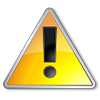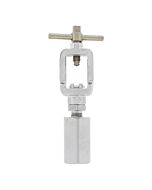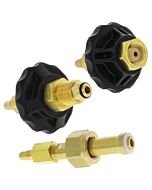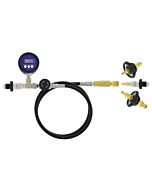DGX Gears Deluxe Fitting and Hose Kit for Booster
- { 96 in | 2.4 m } inlet hose is long enough to reach supply cylinders and has a check valve to prevent back flow
- { 60 in | 1.5 cm } long outlet hose includes a line valve and a DIN Scuba adapter with bleed valve
- Quick connects make it easy to pack the booster for transport and easy to reconfigure as needed
- Also includes CGA-580 helium/argon and a CGA-540 oxygen adapters
- Choose Analog (both psi/bar markings) OR Digital (configurable for psi/bar) gauge
DGX Gears Deluxe Fitting and Hose Kit for Booster
Our Deluxe Fitting and Hose Kit makes our naked boosters a complete solution that includes a quick connect system to provide the ability to transfill or boost from a variety of sources.
The quick connects make it easy to pack the booster for transport and easy to reconfigure as needed. The { 96 in | 2.4 m } inlet hose is long enough to reach even the tallest supply cylinders and has a check valve to prevent back flow. The inlet end of the hose quick connects to any of the three common adapters included in the package: a CGA-580 helium/argon and a CGA-540 oxygen for bulk storage cylinders in the US plus a DIN 477 (aka G 5/8" BSP) thread form connector suitable for use with 200 Bar and 300 Bar DIN SCUBA fittings. Add an optional BS341-3 oxygen/helium international adapter (aka 'Bullnose #3') for connection to bulk storage cylinders outside the US. The { 60 in | 1.5 cm } long outlet hose includes a line valve and a DIN Scuba adapter with bleed valve. The kit also contains a standard BC quick-connect fitting for the drive gas, and quick connect fittings for the inlet and outlet hoses. Additional optional adapters sold separately include the DIN-to-Yoke Spin On Adapter and the DIN-to-CGA870 (aka "medical oxygen") Adapter. Add the optional DGX Tek storage bag to protect the entire kit and gauges when traveling and not in use.
The Haskel kit version includes the SAE/UNF 9/16"-18 input/output and NPT 1/2"-14 drive gas quick connect fittings & adapters for the HK-9000 booster. The DGX Gears kit version includes the NPT 1/4"-18 input/output and PT/BSPT 3/8"-19 drive gas quick connect fittings and adapter for our X-30 booster.
The Analog option includes an analog pressure gauge with both psi/bar markings. The Digital option includes the same fitting and hose system as the analog kit, but substitutes a digital electronic gauge which is user configurable for psi or bar display. The accuracy and precision of the digital gauge makes the system suitable not only for transfilling and boosting, but also for blending.
A nice feature of our Deluxe fitting and hose kit is that the quick connects are oriented such that the inlet and outlet hoses can be plugged directly together without the booster. This means you can use the hoses for transfilling and blending without needing the booster at hand as well.
the maximum service pressure of our entire kit is limited to service pressure of the brass quick-connect couplings, which is {4000 PSIG @ 70 °F | 275 BAR @ 21 °C}. We've seen some unsafe low cost do-it-yourself fitting and hose kits cobbled together from sources like hydraulic supply houses and even Home Depot. The fittings are usually low pressure type and only suitable for "shop air" service at 200 psi. In particular, very few quick connect fittings are rated for high pressure. PTFE S/S braided hose is popular because it's cheap and very flexible, but it's typically only 2400 psi service pressure rated and not particularly durable. If going DIY, please be safe and keep in mind our kits use fittings and breathing air hoses carefully matched to the higher pressure specifications our boosters.
| Brand | DGX Gears |
|---|---|
| SKU | DX-9 |
| Weight | 7.750000 |
Customer Reviews
 WARNING
WARNING
Oxygen-related fires and explosions can result in serious injury or death. According to our suppliers, these products are compatible with oxygen and factory cleaned for use with oxygen. Nonetheless, the 'clean state' of this equipment applies only prior to initial use. Thereafter, periodic inspection and cleaning are a necessity.
Never breathe unblended pure inert gases such as helium that do not contain oxygen, as even a few breaths can cause sudden loss of consciousness without warning. Pure inert gases are sold in compressed gas storage cylinders with a special CGA-580 valve designated for use ONLY with inert gases; never use ordinary diving cylinders with SCUBA valves to store unblended pure inert gas.
You must meticulously follow the recommendations of the US Department of Transportation (DOT), Compressed Gas Association (CGA), and other federal/state/local agencies, plus your training agency for equipment maintenance, handling, storage, labeling, filling, transport and use of compressed gases. Ultimately, you must make the final decision to assume all risks associated with the use of any compressed gases.
YOU MAY ALSO BE INTERESTED IN THE FOLLOWING PRODUCT(S)
How do the grades of compressed oxygen differ?
Nearly all compressed oxygen gas produced in the US is what is known as USP quality, meeting or exceeding United States Pharmacopeia quality standards for human consumption. The gas itself is normally manufactured using cryogenic separation of air, resulting in a gas that is very close to pure oxygen: > 99.5% with the balance being inert gases, mostly argon. There are three grades of compressed oxygen gas widely sold in returnable supply cylinders with the CGA-540 dedicated oxygen connector on the valve: Aviation (aka ABO), Medical, and Industrial (aka Welding). As a practical matter, the differences in the three grades as sold today are not quality of the oxygen being put in the cylinder but rather the procedure used to fill the cylinder and, in the case of Medical grade, licensing or documentation requirements.
Industrial grade oxygen cylinders can be just topped up when refilling and, although unlikely, could be contaminated with other unknown gases that might have back-flowed into the cylinder during use or filling. Aviation and Medical grades must have the cylinder completely evacuated before every fill with each documented and traceable lot being tested for purity. Medical grade oxygen is legally regulated in the US by the Food and Drug Administration and filling a cylinder for medical use incurs some FDA licensing requirements for the cylinder fill station operator.
Medical oxygen is considered a drug, and thus requires a doctors prescription for the FDA licensed fill station operator to fill the cylinder. The FDA has granted an exception to the prescription requirement for medical cylinders marked as emergency use only, but they still should only be filled with USP quality oxygen and following FDA guidelines. To blend breathing gas mixtures for Nitrox and technical diving, most blenders use Aviation grade oxygen to avoid the FDA licensing requirements yet still use an oxygen grade suitable for human consumption.
Among divers, perhaps the most often debated topic about oxygen grades is should industrial grade oxygen be used for SCUBA applications. That's because welding oxygen is relatively cheap and brand name compressed gas suppliers usually fill oxygen cylinders from the same high quality source while following best practices regardless of grade. However, small welding supply operations are more likely to just top up their industrial grade oxygen cylinders from a local bulk supply and may not follow best practices. Unless the entire supply chain for each and every cylinder of oxygen can be trusted with absolute certainty, in our opinion using industrial grade oxygen for diving applications is a needless risk.










